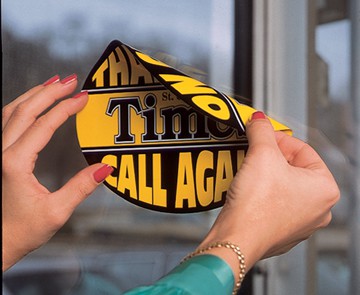Full color vinyl decals are a versatile and eye-catching way to showcase your brand or organization. Made from high-quality vinyl material, these decals can be customized with any image, design, or message you can imagine.
Whether you want to add some personality to your car, promote your business on a storefront window, or decorate your laptop with your favorite sports team’s logo, full color vinyl decals are an affordable and long-lasting option. They are easy to apply and remove but adhere as long as you need them to – within reason, of course – making them a great choice for temporary or permanent usage.
What are Full Color Vinyl Decals Made Of?
 Full color vinyl decals are typically made from a high-quality, durable vinyl (PVC) self-adhesive material that is designed to withstand the elements. This vinyl material is typically white, allowing for vibrant and eye-catching designs that are digitally printed, that are sure to garner attention.
Full color vinyl decals are typically made from a high-quality, durable vinyl (PVC) self-adhesive material that is designed to withstand the elements. This vinyl material is typically white, allowing for vibrant and eye-catching designs that are digitally printed, that are sure to garner attention.
The vinyl material used for full color decals is typically available in matte or gloss. The finish you choose can impact the look and feel of your decal, with matte finishes providing a more subtle, soft look, and glossy finishes offering a more vibrant appearance.
In addition to the vinyl material and finish, full color decals also feature a strong adhesive backing that is designed to securely adhere to a variety of surfaces, including glass, metal, and plastic. This adhesive backing ensures that your decal stays in place even in harsh weather conditions or high-traffic areas.
How to Apply Vinyl Decals

- Clean the surface: Before applying the vinyl decal, make sure the surface is clean and dry. Use a mild soap and water to clean the surface and allow it to dry completely.
- Position the decal: Gently remove the backing paper from the decal and position it on the surface. Use masking tape to hold the decal in place and ensure it is level.
- Smooth out the decal: Starting from the side of the decal where the masking tape is,, use a squeegee or credit card to smooth out any air bubbles and ensure the decal is firmly adhered to the surface.
- Remove the transfer tape: Once the decal is in place, carefully remove the transfer tape by peeling it away at a 90-degree angle or greater. Be sure to go slowly and avoid pulling the decal away from the surface.
- Let it dry: Allow the decal to adhere for at least 72 hours before exposing it to water or other elements. This will ensure that the adhesive is fully purchased, and the decal is securely attached to the surface.
- Note: Do NOT apply in cool temps below 55F or 13C as the adhesive needs to be above these temps to adhere completely.
Do You Apply Vinyl Decals Wet or Dry?
Whether to apply vinyl decals wet or dry largely depends on personal preference and the type of decal being applied. Dry application involves directly placing the decal onto a clean and dry surface without any water or other solutions. This method is typically used for smaller decals or designs with simple shapes.
Wet application, on the other hand, involves using a solution of water and soap to temporarily adhere the decal to the surface, allowing for easier positioning and removal of air bubbles. Wet application is generally used for larger decals or more complex designs. While dry application is quicker and easier, wet application can result in a smoother finish with fewer air bubbles. Your level of experience will also be an important factor in choosing whether or not to dry apply or to apply with liquid. It is important to follow the manufacturer’s instructions and choose the application method that works best for your specific decal and surface.
How Long Does It Take for Vinyl Decals to Dry?
The drying time for vinyl decals can vary depending on various factors such as the size of the decal, the type of adhesive used, and the environmental conditions. In general, it is recommended to wait at least 72 hours if the application temperature is between 55F and 72F (13C and 22C) before exposing the decal to water or other elements to ensure that the adhesive has fully cured. It is always important to read the manufacturer’s instructions carefully to determine the recommended drying time for your specific decal.
What is the Difference Between a Vinyl Decal and a Vinyl Sticker?
Different names for the same product – both are identical and “Decal” and “Sticker” can be used interchangeably.
What is the Difference Between a Transfer Sticker and a Vinyl Decal?
 Transfer stickers and vinyl decals are both types of adhesive graphics that are commonly used for graphic solutions such as bumper stickers (no transfer needed), or an office door where the business name and hours are applied en totale. However, there are some key differences between the two. A vinyl decal is typically a single piece of vinyl material with the design cut out, leaving only the design visible once applied to a surface.
Transfer stickers and vinyl decals are both types of adhesive graphics that are commonly used for graphic solutions such as bumper stickers (no transfer needed), or an office door where the business name and hours are applied en totale. However, there are some key differences between the two. A vinyl decal is typically a single piece of vinyl material with the design cut out, leaving only the design visible once applied to a surface.
On the other hand, a transfer sticker is a three-layer design that includes a backing paper, the decal or sticker material, and a transfer tape. The design is plotted on the vinyl decal material, covered with transfer tape – which peels the decal material from the backing paper – and is then applied to your substrate. This allows for more complex designs and easier application.
Additionally, transfer tape is often used for larger designs, while vinyl decals are better suited for single piece application – basically, think bumper stickers – though there are literally hundreds of uses besides that one.
Can I Make My Own Full Color Vinyl Decals?
Yes, it is possible to make your own full color vinyl decals with the right tools and materials. To create a full color design, you will need a digital image file of the design you want to use and a vinyl printer that can print in full color. You will also need vinyl material, a cutting machine, transfer tape, and a squeegee to apply the decal to a surface.
With these materials, you can print your design onto the vinyl material, cut it out using the cutting machine, and then apply the transfer tape to the decal to transfer it onto a surface. It is important to note that creating your own vinyl decals can be a time-consuming and intricate process, and it may be more cost-effective to have them professionally made.
Do You Use Permanent or Removable Vinyl for Decals?
Whether to use permanent or removable vinyl for decals depends largely on the desired application and length of use. Permanent vinyl is designed to adhere strongly to surfaces up to 5 years, and is ideal for long-term outdoor applications, such as outdoor signage or branding materials. Removable vinyl, on the other hand, is designed to be easily removed without leaving any residue or damage to the surface. This makes it ideal for temporary applications, such as event signage or seasonal decor, and even bumper stickers.
Ultimately, the choice between permanent and removable vinyl will depend on the intended use of the decal. If you plan to use the decal for a long time or in harsh weather conditions, then permanent vinyl is the better choice. However, if you are looking for a temporary option that can be easily removed without damage within 6 to 12 months, then removable vinyl is the way to go.
Will Air Bubbles in Vinyl Decals Go Away?
If air bubbles persist after application, they can often be removed by puncturing the bubble with a sharp blade such as an Exacto® knife, then smoothing the air out the vinyl. However, it is important to note that some types of vinyl may be more prone to air bubbles than others, and it is always best to follow the manufacturer’s instructions for application to minimize the risk of bubbles forming in the first place. Egress vinyl material is one solution that virtually eliminates air bubbles.
Do Full Color Vinyl Decals Peel Off Easily?
 The ease with which full color vinyl decals peel off will depend on the type of vinyl used and the surface to which it is applied. Generally speaking, high-quality vinyl decals should adhere strongly to most surfaces, making them durable and long-lasting. However, if the surface is dirty, oily, or otherwise not properly prepared for application, it can cause the decal to peel off more easily over time.
The ease with which full color vinyl decals peel off will depend on the type of vinyl used and the surface to which it is applied. Generally speaking, high-quality vinyl decals should adhere strongly to most surfaces, making them durable and long-lasting. However, if the surface is dirty, oily, or otherwise not properly prepared for application, it can cause the decal to peel off more easily over time.
In addition, some vinyl materials are designed to be more easily removable than others, which can be useful for temporary applications. If you need to remove a vinyl decal, it is best to do so slowly and carefully, using a heat gun or hair dryer to soften the adhesive and make it easier to peel off.
Is It OK to Clear Coat Over Vinyl Decals?
Clear coating over vinyl decals can be a good way to protect and preserve the decal, but it is important to use the right type of clear coat and to apply it properly. The most important thing to keep in mind is that the clear coat should be compatible with the type of vinyl used in the decal. When done properly, clear coating can provide an extra layer of protection and durability for vinyl decals, making them more resistant to scratches, fading, and other damage over time. Over-laminate will replace clear coating on digitally printed vinyl decals typically.
How Long After Applying Vinyl Decals Can I Clear Coat or Laminate?
The length of time you should wait before applying clear coat/laminate over vinyl decals can vary depending on a number of factors, including the type of vinyl used, the surface to which it was applied, and the temperature and humidity conditions during application. In general, it is best to wait at least 24-48 hours after applying the vinyl decal before applying a laminate/clear coat. This allows the adhesive to fully dry and the vinyl to conform to the surface, reducing the risk of air bubbles or other imperfections forming under the clear coat.
If you are working with a high-quality vinyl and applying to a properly prepared surface, you may be able to apply the clear coat sooner, but it is always best to err on the side of caution and wait until the vinyl is fully set before sealing it with a clear coat. Again, always follow the manufacturer’s instructions.
What Happens if I Clear Coat on Vinyl Decals Too Soon?
If you clear coat on vinyl decals too soon, it can cause a number of issues that can compromise the quality and durability of the decal. The most common problem is that the clear coat can trap air bubbles or wrinkles under the surface, creating a bumpy or uneven finish. This can also cause the decal to lift or peel away from the surface over time.
Additionally, if the vinyl print has not fully cured, the clear coat can react with it and cause the decal to become discolored. If you notice any problems with the decal after applying a clear coat too soon, it may be necessary to remove the decal and start over again, which can be time-consuming and costly.
Do Vinyl Decals Go on Before or After Wax?
Vinyl decals should be applied before waxing a vehicle or surface. This is because wax will retain the decal image if it is applied after the decal is applied.
Can Vinyl Decals Get Wet?
Vinyl decals can get wet without any problem, as long as they are of good quality and have been properly applied. Vinyl is a water-resistant material, which means that it can withstand exposure to moisture without being damaged or losing its adhesive properties. They are usually impervious to inclement weather, but not harsh chemicals or abrasive cleaning methods that can damage the vinyl and cause it to deteriorate over time. To ensure that your vinyl decals last as long as possible, it is best to avoid exposing them to harsh cleaning agents, and to take care when cleaning around the decal to avoid causing damage.
How Long Should Paint Dry Before Applying Vinyl Decals
 The length of time you should wait before applying vinyl decals on freshly painted surfaces depends on the type of paint and the environmental conditions. In general, it is recommended to wait at least a week due to the off-gassing of the paint as it cures – before applying vinyl decals.
The length of time you should wait before applying vinyl decals on freshly painted surfaces depends on the type of paint and the environmental conditions. In general, it is recommended to wait at least a week due to the off-gassing of the paint as it cures – before applying vinyl decals.
Also, if the weather is particularly humid or cold, it may take longer for the paint to dry, and you should wait until it is completely cured before applying the decal. It’s important to follow the manufacturer’s recommendations for the paint and to test a small, inconspicuous area first to ensure that the decal adheres properly.
How Long Do Full Color Vinyl Decals Last?
The lifespan of full color vinyl decals depends on several factors, including the quality of the vinyl, the print quality (digital inks typically last longer than screen-printed inks before fading in sunlight), the environmental conditions, and the amount of exposure to sunlight and other elements. High-quality vinyl decals can last up to 5 years or more when applied to a clean, smooth surface and properly maintained.
However, if the decal is exposed to direct sunlight or extreme weather conditions, such as excessive heat or cold, it may begin to fade or deteriorate more quickly. Also, harsh chemicals or abrasive cleaning methods can damage the vinyl and cause it to peel or crack. To extend the lifespan of your vinyl decals, it’s important to apply them to a clean, dry surface and avoid exposing them to excessive sunlight or chemicals.
Conclusion
Full color vinyl decals are a popular and versatile way to add a personalized touch to a variety of surfaces. They can be used for branding, advertising, decorating, and identification purposes, and can be applied to everything from cars and windows to walls and laptops. With proper application and maintenance, they can provide a durable and cost-effective way to enhance the look and functionality of your personal or business space.
Popular Posts:




